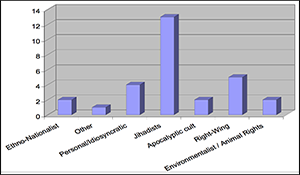The New Horizons in Bioterrorism Workshop


New Horizons in Bioterrorism.
Author | Editor: Canna, S. (NSI, Inc) & Ackerman, G. (University of Maryland, START).
The objective of the New Horizons in Bioterrorism workshop, held on 11-12 August 2008 in Arlington, Virginia, was to explore existing and future developments in bioterrorism through the elicitation and generation of adversary courses of action (ACOAs) and associated indicators. Ten bioterrorism subject matter experts (SMEs) were invited to explore bioterrorism indicators, plots, and capabilities through 2015. The workshop addressed both existing and future developments in biological terrorism through the elicitation and generation of bioterrorism ACOAs, as well as indicators associated with those activities. Through the exploration of both existing and potential paradigms, the workshop participants sought to provide the sponsors with a better understanding of the processes and procedures preceding a biological terrorism attack.
The unclassified workshop was the first step in a three-phase program supported by the U.S. Special Operations Command for the Joint Intelligence Preparation of the Operational Environment (JIPOE) and the Strategic Multilayer Assessment (SMA) programs. The goal of the WMD-T (Weapons of Mass Destruction – Terrorism) JIPOE is to develop a national-level combating WMD-Terrorism forecasting or inferential strategic assessment capability covering full threat spectrum from intent to act, to preparation, and all the way downstream to deployment by non-state actors (i.e. far left of “boom” to just left of “boom”). This requires a decidedly new adaptive and dynamic forecasting and alerting approach. SMA will provide concepts and tactics, techniques, and procedures (TT&Ps) for establishment of a national, federated WMD-T JIPOE enterprise to provide shared understanding and action orientation to the WMD-T threat domain.
The second phase of the program will employ a Bayes Net Risk Analysis model and an Automated Behavioral Analysis model to generate priority threat scenarios. The third phase will integrate the ACOAs from Phase I, risk estimates from Phase II, and a historical analysis in a classified session to evaluate and prioritize ACOAs. Intelligence or knowledge gaps will be identified and a top ten list of threats will be generated.

